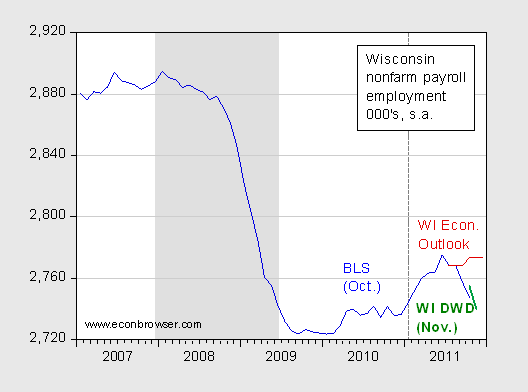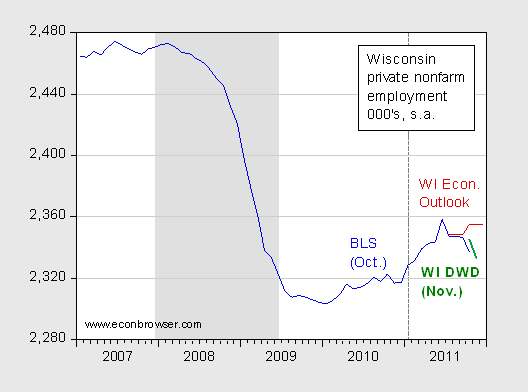That’s the concluding line from the release issued by the Wisconsin Department of Workforce Development’s Secretary Reginald Newson. The preceding sentence is “The job numbers are a lagging indicator for economic conditions, and we will continue to move forward.” Here are two graphs, with updated DWD data incorporating revisions, and preliminary data for November, that place those comments in context.

Figure 1: Wisconsin nonfarm payroll employment from BLS (blue), from DWD (green bold), and projections from October Wisconsin Economic Outlook, in 000’s. NBER defined recession dates shaded gray. Vertical line at 2011M01. Sources: BLS, WI DWD, Wisconsin Economic Outlook and NBER.

Figure 2: Wisconsin private nonfarm payroll employment from BLS (blue), from DWD (green bold), and projections from Wisconsin Economic Outlook, in 000’s. NBER defined recession dates shaded gray. Vertical line at 2011M01. Sources: BLS, WI DWD, October Wisconsin Economic Outlook and NBER.
Secretary Newson stressed the fact that the preliminary numbers, calculated in cooperation with BLS, had underestimated private employment.
“October was the fifth straight month and the eighth month this year in which the federal government
overestimated the preliminary job loss numbers or underestimated job gains for Wisconsin,” Secretary
Newson said. “I am particularly concerned by the disparity in the October preliminary numbers, which were
off by 7,300 for total jobs and 7,900 for private-sector jobs. These unreliable employment statistics out of
Washington misinform the public and create unnecessary anxiety for job seekers and job creators about the
shape of our state’s economy.”
So the general warning to not interpret a single month’s change in employment numbers as a trend applies a fortiori to state level data. However, as the Milwaukee Sentinel Journal notes (h/t Jake):
On average, Wisconsin has lost 4,980 private-sector jobs each month for the past five months.
John Heywood, an economics professor at the University of Wisconsin-Milwaukee, said the state data is prone to sample error and revision. But after five months of consecutive declines, he said the decreases cannot all be attributed to statistical error.
“We all know there is random variation in the state estimate and that revisions often move that estimate. All true,” Heywood said. “It is very unlikely that the pattern simply results from sampling error. The survey design is imperfect, but typically not that imperfect.”
Hence, unless there is a drastic revision in November’s numbers, the gradient remains downward. [1] [2]
Menzie, the poll is quite accurate due the diverse nature of the family. They were very unhappy with George Bush. They now feel Obama is Bush on steroids. The change they voted for is not the change they have seen. So…. I’ll stand by the latest family poll, but we will have one more during a reunion in Aug/Sep. It will be more accurate for WI as the balance of relatives, I’d say more then 50%, will be from WI and the numbers will be around 100. It looks like both WI Dems and National Dems are in deep trouble, but there are areas such as CA where they still poll strong. BTW, you are welcome to visit the real WI anytime. Let me know!
Steve- Spare me- Obama is up double digits in Wisconsin on any of the clowns the GOP will nominate for the presidency. Even though Obama hasn’t gone far enough, which has put a dent in his popularity (so he might win 54-45 vs. 56-42 in ’08), the Walker disaster has soured much of the independents in the state on ever voting GOP again. This ESPECIALLY true in rural Wisconsin, where the cuts to shared state revenues, schools, and mill closings have been hitting hard.
In fact, watch how GOP presidential candidates are going to have straddle the line in April’s Wisconsin GOP primary, because Walker will be facing the recall election at the same time, and if I wanted to win any moderate Wisconsinite’s vote in November, I would not come close to being associated with an economic failure like Scott Walker.
James Hamilton is an Economist, first and foremost.
But Menzie is a leftist first and Economist second. This is evidenced by how he tosses out Econ 101 ideas when any lefty sacred cow is at risk.
To quote Ricardo this is further evidence that “we are beginning to see two Americas.”
And yes, things are definitely continually and gradually moving in the”right” direction in Wisconsin (at least until the recall election in April). That is, if by “right” you mean in the same direction as Alabama, Mississippi and Texas. Those happily Republican governed states have all faced massive state and local budget shortfalls this budget year (13.4%, 13.8% and 20.5% respectively), and all despite the benefit of having relatively low public worker unionization rates. The response to this massive budget shortfall in all these glaringly low tax states? Well, shlash and burn essential public services of course. In Alabama, the Department of Public Health saw its budget cut by 37% (but hey, public health is way overrated). In Mississippi the state defaulted on its statutory obligations to local school districts for the fourth year in a row (Missippians have gotten by for years without being literate so why change things now). In Texas they cut Medicaid by 29% and fired 100,000 school employees. (When you rank near the bottom of the country in almost every measure of health or education attainment how could it hurt?)
So with all of these massive cuts to state and local government expenditures the confidence fairies naturally arrived and led to a massive boom, right? Well, not exactly. In the past year Alabama, Mississippi and Texas have been among only a handful of states to see their unemployment rates actually rise from 9.1% to 9.3%, from 10.2% to 10.6% and 8.2% to 8.4% rewspectively during a time when the nation’s as a whole declined from 9.7% to 9.0%. Evidently contractionary fiscal policies are still, well, em, contractionary.
Meanwhile in a very different parts of the country, with Democratically controlled local governments, we see a different picture. In Colorado, Delaware and Massachusetts budget shortfalls have been modest to nonexistent (6.2%, 0.0% and 5.6% respectively). Much of this has to do with a greater willingness to levy taxes to pay for essential public services. Cutbacks were made in Colorado and Massachusetts but despite the loss of federal stimulus money Massachusetts actually managed to raise its budget for education to a record level. (Something about “investing in the future” I believe.)
So, naturally by limiting cutbacks to expenditures on essential public services these states with moderate to high rates of public union membership were subject to a wrath of fury from the confidence fairies, right? Well, em, no. Colorado, Delaware and Massachusetts have seen their unemployment rates fall from 8.9% to 8.1%, from 8.4% to 7.9% and from 8.3% to 7.3% respectively.
But the important thing to remember is that Scott Walker has Wisconsin heading in the “right” direction. He pledged to create 250,000 jobs in his first four year term. In his first ten months he’s added 16,300. OK, so maybe it will take a little longer (i.e. four terms?). But given that Wisconsin had the highest rate of high school completion within four years (89.6%) in the nation before Walker decided to give public education the shaft it’ll probably take him that long to turn Wisconsin into that highest of Republican ideals: Mississippi.
P.S. Of course a recall election may intefere with his noble dream. Those nasty Democrats are only 32,000 short of the 540,000 necessary signatures and they did that in little over half of the alloted time. Sounds like those silly Wisconsinites don’t want to become like Mississippi to me.
P.P.S. Merry Christmas from that Blue state Hell on earth known as Delaware.
Mark, why not compare the really illustrative, democratically controlled states say, IL, MI and CA?
CoRev MI is a GOP controlled state.
2slugs, you are correct. Repubs have controlled the Governor and legislature for just less than a year.
Actually CA is an interesting point, since they had a GOP gov until this January, and GOP-leaning laws that limit tax increases. Jerry Brown has now taken over, and Cali has the biggest job growth over the last 4 months.
Illinois was also the largest job gainer in the country for October, and has passed Wisconsin and Indiana in job growth since the start of this year- which kind of goes against Walker’s and Daniels’ theories of stealing jobs from “high-tax” Illinois, doesn’t it?
Mark Sadowski is correct- the Southern style of low taxes, low services and high poverty does not translate into job growth or better economic performance. So it makes you wonder why Scott Walker wanted to use that paradigm in Wisconsin (well, until you start following the money that’s flowed into Walker’s campaigns, then it’s not so surprising).
Jake, here’s the annual numbers for the top ten states. From here: http://www.signonsandiego.com/news/2011/dec/04/california-top-10-job-growth/
Top 10 states for job growth
From October 2010 to October 2011, the following states had the fastest job growth:
N. Dakota 4.86%
Oklahoma 3.05%
Utah 2.62%
Louisiana 2.34%
Texas 2.23%
Nebraska 2.00%
Montana 1.94%
Arizona 1.89%
Wyoming 1.72%
California 1.72%
I think we can make a case for N. Dakota being an example of what can happen with a reasonable energy policy, one such provided by the republican governor and legislature.
CoRev,
Am I missing something? Republicans control both houses and the Governorship of Michigan. Is there something else that they wish to take control of before they eventually take responsibility for the unbelievable disaster that is Michigan?
I think Jake has addressed CA.
Also, can the Republicans create jobs in any way other than bouncing off of a hard bottom or slurping someone elses milkshake? Based on the examples you provided they obviously can’t.
CoRev, I think almost every single one of the leading job gainers you listed are energy plays. I’m not sure about California, but I would speculate that fracking works there, too.
How many are right-to-work states? Every single one but California?
mark, yes, the repubs in their short 11 month tenure are responsible for the past decade of MI economic performance. Even though the governor for the past two terms was a Dem?
At least blame some/most of it on the union pandering done by the MI politics.
Engineer, I think you caught my drift. Wish to compare world economies and see if there is an energy component to their economic performance? Once finished with that, compare the worlds’ economies which provide raw resources. Betcha we’ll find some correlation to success.
CoRev, I think it is a mistake to look at raw job growth numbers. That does not account for jobs which may be a function of faster population growth. A better measure of employment performance is the employment/population ratio. I would be curious to see how the states stack up over the last year on that measure. I have done the analysis using that measure since the recession began in December 2007 as part of a debunking of Political Math’s widely circulated claim that Texas has had the best job performance in that time, despite adding two unemployed persons to its labor force for every new job. See my post here: http://middleclasspoliticaleconomist.blogspot.com/2011/09/whats-up-with-political-math.html